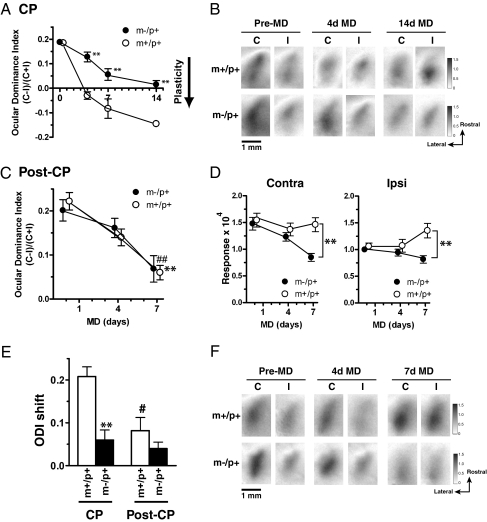Fig. 2.
Lack of rapid OD plasticity after brief MD and effects of prolonged MD during and after CP in m−/p+ mice. (A) OD shifts after brief and prolonged MD in m−/p+ and m+/p+ mice at the peak of CP. It requires 14d MD in m−/p+ mice (closed circles) to elicit OD shifts that are comparable to those in m+/p+ mice (open circles) after only 4d MD. Plasticity is significantly less in m−/p+ mice than in m+/p+ mice with corresponding durations of MD (n = 8–9; **P < 0.01 vs. m+/p+). (B) Response magnitude maps for the contralateral (C) or ipsilateral (I) eye before (pre-MD) and after 4d and 14d MD in m+/p+ and m−/p+ mice at the age of CP. (C) OD shifts elicited by 7d MD in m+/p+ (open circles) and m−/p+ (closed circles) mice after the CP (post-CP) beginning at P33–37 (n = 5–7; **P < 0.01, m+/p+ at pre-MD vs. m+/p+ at 7d MD; ##P < 0.01, m−/p+ at pre-MD vs. m−/p+ at 7d MD). (D) Maximum magnitude of eye-specific responses for the contralateral (contra, Left) and ipsilateral (ipsi, Right) eyes before and after 4d and 7d MD in m+/p+ (open circles) and m−/p+ (closed circles) mice at the age of post-CP (n = 5–7; **P < 0.01). (E) Net OD shifts elicited by brief (4d) MD during CP and after (post-CP) in m+/p+ (white bars) and m−/p+ mice (black bars) (n = 5–9; **P < 0.01, m−/p+ vs. m+/p+ in CP; #P < 0.05, CP vs. post-CP in the same genotype). (F) Response magnitude maps for the contralateral or ipsilateral eye before (pre-MD) and after 4d and 7d MD in m+/p+ and m−/p+ mice at post-CP.

